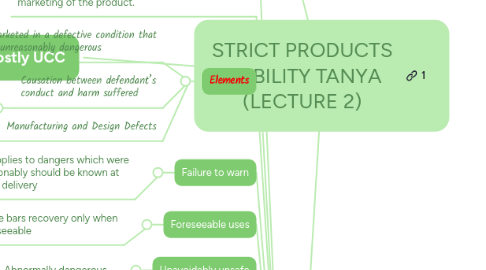
1. Breach of Warranty - mostly UCC
1.1. Misrepresentation of a material fact
1.2. Implied warranty in tort
1.3. UCC Warranties
1.3.1. Breach of express warranty
1.3.2. Implied warranty of merchantability
1.3.3. Implied warranty of fitness for a particular purpose
2. Liability for Negligence
2.1. Liability with regard to particular unit
2.2. Negligence in design
2.3. Negligence in instructions or warnings
2.4. N in manufacturing/construction
2.5. Proper P: anyone reasonably foreseeable
3. Strict Product Liability - not services
3.1. Mfr or supplier of product that is defective and unreasonably dangerous can be held strictly liable when product causes injury to user or their property
3.1.1. Risk must be of physical harm to persons or tangible property
3.1.2. Prove Defect in product
3.1.2.1. AND unreasonably dangerous
3.1.2.1.1. during intended use or unintended but foreseeable use
3.2. Manufacture is strictly liable whenever the product departs from its intended design even though all possible care was exercised in the preparation and marketing of the product.
3.3. Elements
3.3.1. Marketed in a defective condition that is unreasonably dangerous
3.3.1.1. Manufacturing and design defects
3.3.2. Causation between defendant’s conduct and harm suffered
3.3.2.1. Misuse breaks the chain of causation
3.3.2.1.1. unless foreseeable misuse
3.3.3. Manufacturing and Design Defects
3.4. Failure to warn
3.4.1. Only applies to dangers which were or reasonably should be known at time of delivery
3.5. Foreseeable uses
3.5.1. Misuse bars recovery only when unforseeable
3.6. Unavoidably unsafe
3.6.1. Abnormally dangerous
3.6.1.1. Liability regardless of level of care to prevent harm
3.6.1.1.1. toxic chemicals
3.7. Reasonable design
3.7.1. Consumer contemplation test
3.7.2. Risk utility test
3.7.2.1. risk outweighs social utility?
3.7.2.1.1. jury
3.8. Causation
3.8.1. Unforeseeable modification or alternation constitutes superseding cause of injury
3.8.2. Plaintiff’s misuse of product removes liability
3.9. Individuals who may be liable - possible D's
3.9.1. Manufacturers, suppliers and lessors
3.9.1.1. Seller: Engaged in the regular business of selling such a product
3.9.1.1.1. rt of indemnification ag. manufacturer
3.9.1.2. Product is expected to reach consumer without substantial change in condition
3.9.1.2.1. tide pods
3.9.1.3. Manufacturer of whole product liable for assembly also, even if improperly assembled by seller
3.9.2. Does not apply to performance of services
3.9.3. Where precise manufacturer cannot be determined, cts may allocate to a group of manufacturers who manufacture an identical prod.
3.10. Individuals protected - possible Ps
3.10.1. Subsequent purchasers
3.10.2. anyone reasonably foreseeably likely to be injured -- Persons likely to be hurt
3.10.3. Privity not required unless it’s a breach of warranty
3.10.4. Users consumer and bystanders
3.11. Defenses
3.11.1. If product defect was caused by subsequent change made by 3rd party
3.11.2. Unforeseeable modification or alteration is superseding cause of injury
3.11.3. Contributory negligence is NOT a defense
3.11.3.1. But unreasonable assumption of the risk by Plaintiff is a defense
3.11.3.1.1. Plaintiff’s voluntary and unreasonable use of the product
3.11.3.1.2. Knowledge of the defect and danger it presents
3.12. Recovery
3.12.1. Limited to the kind of harm for which activity was determined to be abnormally dangerous
